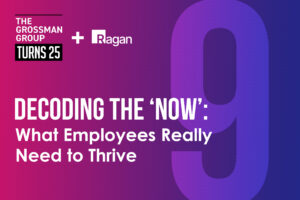Collaborating with managers to improve employee engagement
Discover your organization’s untapped potential through the transformative impact of effective communication strategies on workplace morale and productivity.

No one benefits from an unhappy workforce. Yet detached and unmotivated employees seem to be everywhere.
Last year, for example, two-thirds of U.S. workers reported feeling either not engaged or actively disengaged on the job, according to Gallup. These dissatisfied employees cost companies an estimated $1.9 trillion in lost productivity. Ouch.
It doesn’t have to be this way. Both managers and employees can do their part to boost morale in the workplace — and it begins with a sound communications strategy.
For those in leadership positions, the key is to establish an ongoing dialogue with subordinates. Employees want to know what’s happening and why. Who did the business just hire? How did the department perform last quarter? Keeping people in the loop on a routine basis makes them feel more connected to the company. More transparency leads to fewer misunderstandings and a more self-assured work environment. It’s the internal communicator’s job to set benchmarks and measurements to understand which channels employees prefer to receive communications, how often and what format works best.
Employees also want to express their opinions and be heard. The more their superiors listen and act on the input, the more workers will invest their time and energy into the company.
Managers should set up regular calls or schedule recurring meetings on internal communications platforms such as Slack, as they can no longer rely on news spreading around the office in an informal manner. While remote work has declined since the height of the pandemic, numbers from the Census Bureau show that around 26% of U.S. households still have someone working from home at least one day per week. A more formal approach to disseminating information cuts down on unfounded gossip, too.
Internal communicators can partner with team managers by collaborating on crafting effective messaging that resonates with employees, providing resources and training on communication strategies, and offering consistent feedback and support. By aligning their efforts and actively involving team managers in the communication process, internal communicators can ensure that messaging is relevant, timely and tailored to the specific needs of employees, ultimately leading to increased engagement and stronger relationships within the organization. This partnership allows team managers to be champions of communication within their teams and encourages a culture of transparency, trust and open dialogue throughout the organization.
Providing feedback — both positive and constructive — is also crucial. Employees want to know that their individual efforts serve a greater purpose by contributing to the company’s overall success. As additional findings from Gallup put it, people “want to be known for what makes them unique.” Managers, therefore, can help drive employee engagement by celebrating good work in a public setting. Reward a job well done, whether that’s in a group email or an all-hands Zoom meeting.
On the other hand, while criticism can be hard to hear, it signals to employees that what they do, and how they do it, matters. Someone cares enough to point out flaws. That said, best to have these conversations in private.
At the same time, employees shouldn’t feel like passive viewers of their own careers. Communication is a two-way street. Managers should encourage workers to submit their ideas and share their day-to-day frustrations before they snowball into bigger issues that push them into adopting a “quiet quitting” mindset. The more available and approachable managers can make themselves — within a healthy work-life balance, of course — the better.
Ultimately, employees want the respect that comes from reliable communication. They want the trust that accompanies a lasting relationship. Although 82% of employees believe it’s important for their organization to see them as a person rather than just an employee, only 45% say their organization sees them this way, according to research from Gartner. This is a big opportunity for companies looking to increase engagement and extend employee retention rates.
By working together, managers and employees can create a work culture that fosters a robust sense of camaraderie and collaboration. Whether it’s a client or customer, boss or worker, everyone will be better off because of it.






